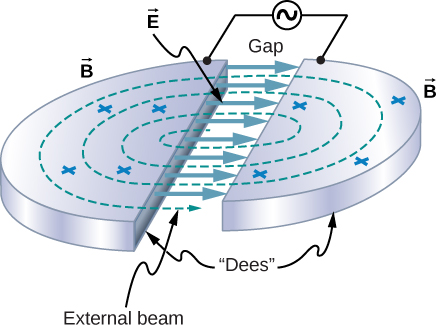| << Chapter < Page | Chapter >> Page > |
Check Your Understanding How much energy does an electron receive in accelerating through a 1-V potential difference?
1 eV
The next-generation accelerator after the linac is the cyclotron ( [link] ). A cyclotron uses alternating electric fields and fixed magnets to accelerate particles in a circular spiral path. A particle at the center of the cyclotron is first accelerated by an electric field in a gap between two D-shaped magnets (Dees). As the particle crosses over the D-shaped magnet, the particle is bent into a circular path by a Lorentz force. (The Lorentz force was discussed in Magnetic Forces and Fields .) Assuming no energy losses, the momentum of the particle is related to its radius of curvature by
where p is the momentum in GeV/ c , B is in teslas, and r is the radius of the trajectory (“orbit”) in meters. This expression is valid to classical and relativistic velocities. The circular trajectory returns the particle to the electric field gap, the electric field is reversed, and the process continues. As the particle is accelerated, the radius of curvature gets larger and larger—spirally outward—until the electrons leave the device.

Watch this video to learn more about cyclotrons.
A synchrotron is a circular accelerator that uses alternating voltage and increasing magnetic field strength to accelerate particles to higher energies. Charged particles are accelerated by RF cavities, and steered and focused by magnets. RF cavities are synchronized to deliver “kicks” to the particles as they pass by, hence the name. Steering high-energy particles requires strong magnetic fields, so superconducting magnets are often used to reduce heat losses. As the charged particles move in a circle, they radiate energy: According to classical theory, any charged particle that accelerates (and circular motion is an accelerated motion) also radiates. In a synchrotron, such radiation is called synchrotron radiation . This radiation is useful for many other purposes, such as medical and materials research.
The momentum energy is much larger than the rest mass energy of the electron, so relativistic expression for the energy of the electron must be used (see Relativity ). The total energy of the electron is

Notification Switch
Would you like to follow the 'University physics volume 3' conversation and receive update notifications?